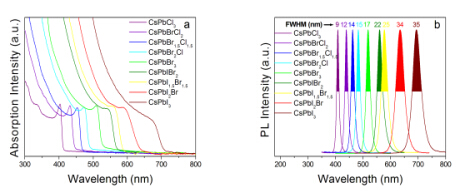 |
Figure 1. Schematic diagram of the cubic cell structure of CsPbCl3, CsPbBr1.5Cl1.5, CsPbBr3, CsPbI1.5Br1.5, and CsPbI3 perovskite quantum dots (a), XRD spectrum (b), and EDS energy spectrum (c). FESEM photograph (d) of the CsPbBr3 perovskite quantum dots, the TEM photo results in the upper right corner.

Figure 2. Absorption (a) and fluorescence emission spectra (b) of normalized perovskite quantum dots of CsPbCl3, CsPbBr1Cl2, CsPbBr1.5Cl1.5, CsPbBr2Cl1, CsPbBr3, CsPbI1Br2, CsPbI1.5Br1.5, CsPbI2Br1 and CsPbI3.
Recently, Zeng Qinghui, associate researcher at Changchun Institute of Optics, Fine Mechanics and Physics, Chinese Academy of Sciences, proposed a new simple and easy operation method to synthesize different halogen-doped high-performance CsPbX3 in the visible spectrum (X=Cl, Br, I) Perovskite Quantum Dots. The highest quantum yield of perovskite quantum dots can be up to 95% (the highest value for perovskite QDs reported internationally). The narrowest peak width at half maximum can reach 9 nm. (It is the smallest quantum dot sample reported in the world at present), the stability has been significantly improved, and this work has important significance for the preparation of perovskite quantum dots and their application in the field of optoelectronic devices. The research results were published on ACS Applied Materials & Interfaces.
Quantum dots, also known as semiconducting nanocrystals, are obtained in the fields of biomedical, LED and solar cells due to their excellent optical properties (eg, excitation linewidth, narrow emission spectrum, high fluorescence efficiency, quantum size effects, etc.) With extensive application research, the higher the fluorescence efficiency and stability, the narrower the half-peak width (the better the monochromaticity), the wider the application of quantum dots in these fields will be. In recent years, halogen-doped CsPbX3 (X = Cl, Br, I) perovskite quantum dots (PQDs) due to their higher fluorescence quantum yield, narrow fluorescence emission spectrum and fluorescent color with halogen doping different adjustability The excellent optical performance is further concerned by researchers. So far, the stability of CsPbX3 perovskite quantum dots is still a scientific problem to be solved urgently. The reason for this is mainly the traditional CsPbX3 perovskite quantum dots. In particular, the preparation of mixed-halogen CsPbX3 perovskite QDs is mostly accomplished at lower temperatures (40°C) by anion exchange techniques. It often leads to a decrease in fluorescence efficiency and stability.
The work of the researchers aimed at improving the fluorescence efficiency and stability of CsPbX3 (X = Cl, Br, I) perovskite quantum dots. Different from the previously reported CsPbX3 perovskite QDs obtained at 40°C by anion exchange technique, the researchers synthesized single or mixed halogen CsPbX3 perovskite QDs directly under high temperature conditions (~180°C) by thermal injection techniques. Through the synthesis method of Zeng Qinghui and other researchers, the surface ligand can be more effectively coordinated to the surface of the perovskite quantum dot, thereby contributing to improving its optical properties and improving its stability. During the experiment, the researchers used a relatively green and safe OA/OA amine ligand to replace the traditional highly toxic mixture of OA/OAm/TOP ligands to synthesize CsPbX3 perovskite quantum point. Compared to previous stringent synthesis methods requiring vacuum and glove box equipment, they provide a simple method requiring only argon inert gas protection; conditions such as reaction temperature, ligand ratio, reaction time, and ratio of different halogen atoms With precise control and heat injection techniques, the researchers prepared a series of high-performance single- and mixed-halogen CsPbX3 (X=Cl, Br, I) perovskite quantum dots.
The CsPbX3 (X = Cl, Br, I) perovskite quantum dots prepared by the method of Zeng Qinghui et al. have a high fluorescence quantum yield (40-95%, the highest value can reach 95%, is currently reported solution The highest fluorescence quantum yield of the CsPbX3 perovskite quantum dot sample), the narrower half width (9-35 nm, the narrowest half width value of 9 nm, is the smallest half width of the currently reported solution quantum dot sample). Values), as well as higher light stability, the peak position of the emission spectrum can be continuously adjusted (408-694 nm) in the visible spectral region with different halogen-doping elements, which will favor CsPbX3 perovskite quantum dots in such as LED Solar cells and other optoelectronic devices are widely used. In addition, the researchers used a 1×1×2 supercell to construct a crystal model of a mixed halogen CsPbX3 perovskite quantum dot, calculated the energy band structure, and compared the band gap with the peak position in the fluorescence emission spectrum. The direct band gap on the test agrees well with the experimental results. The research work shows that the CsPbX3 (X=Cl, Br, I) perovskite quantum dots show potential in optoelectronic devices, and have broad prospects for development.
The research work was supported by the Jilin Province Science and Technology Development Plan Project, the Chinese Academy of Sciences Green Promotion Association, and the National Natural Science Foundation Project.
Vde Injection Ring Spanner,Vde/Gs Certificate Ring Spanner,En60900 Approved Ring Spanner,1000V Insulation Ring Spanner
Shanghai Countool In't Trading Co.,ltd , https://www.countool.com